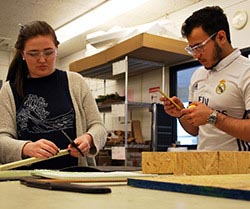
Through DESIGN’s first-year engineering design course, students learn the foundations of engineering through hands-on team projects, designing technically feasible, economically viable and desirable solutions to real-world problems. IMAGE: PENN STATE
Setting the cornerstone for engineering students
Engineering design enhances undergraduate program offerings
12/18/2020
By Samantha Chavanic
UNIVERSITY PARK, Pa. — The engineering design (DESIGN) program, housed in the College of Engineering’s School of Engineering Design, Technology, and Professional Programs (SEDTAPP), provides undergraduate engineering students with what is often their first exposure to engineering concepts and skills. Through the program’s first-year engineering design course, students learn the foundations of engineering through hands-on team projects, designing technically feasible, economically viable and desirable solutions to real-world problems. These projects highlight the role engineering plays in improving the health, safety and welfare of the global community.
To better reflect the impact DESIGN has on engineering education at Penn State and to better align with the needs of today’s engineering students, the program’s undergraduate offerings have been redesigned, renamed and renewed.
Between 2015 and 2018, the course curriculum for EDSGN 100: Introduction to Engineering Design, the first-year engineering course taken by the majority of engineering students at Penn State, was redesigned to reflect evolving educational needs, to harmonize content across sections and campuses and to better integrate course components via the course’s design projects, including client-sponsored projects. The course’s redesign incorporated five recurring, general goals and learning outcomes: apply engineering design to address design opportunities; use systems thinking and apply it to engineering design; develop professional skills necessary for becoming a successful engineer; communicate engineering concepts and designs and gain experience in hands-on fabrication while developing a “maker mindset.”
In spring 2018, DESIGN faculty completed the redesign by using these five goals to identify student learning outcomes and grading schemes, standardize general course content and document teaching best practices. Before this renewal, the most recent major course update occurred in 1995 when the course designator was changed from Engineering Graphics (EG) to Engineering Design and Graphics (ED&G), signifying the shift from a predominately graphics-based course to one incorporating team-based design projects. In 1998, the course won the Boeing Engineering Educator’s Award, which recognized this significant shift and course innovations. In 2007, Penn State retired the ED&G designator and the designator EDSGN was created to better reflect the increased engineering design focus and new upper-level engineering design courses offered by SEDTAPP.
“The most recent redesign has afforded the EDSGN 100 instructors an opportunity to reflect on the best ways to prepare our students through teaching foundational skills that will be built upon in their engineering curricula,” said Sarah Ritter, associate director of DESIGN and associate teaching professor of engineering design. “The redesign was really strengthened by the varied expertise of our interdisciplinary faculty to develop content that is both relevant and broadly applicable across engineering disciplines. The new name ‘Cornerstone Engineering Design’ underscores the role of the course in the engineering student’s educational journey and professional development.”
The completed redesign resulted in a new course title that reflects the significant role EDSGN 100 plays in engineering students’ academic careers. EDSGN 100: Cornerstone Engineering Design serves as students’ introduction to fundamental engineering design skills, techniques and tools that are built upon and enhanced as they advance in their Penn State engineering education.
Annually, more than 3,000 students across 20 of Penn State’s 24 campuses enroll in EDSGN 100. More than 50 instructors teach more than 70 sections of EDSGN 100 to these students each year. These numbers reflect the true impact Cornerstone Engineering Design has on the Penn State community, the engineering community and the global community.
“Penn State engineering has a long history of educational innovation within its first-year course, and once again our leadership in this area will have significant impact nationally,” said Sven Bilén, SEDTAPP head and professor of engineering design, electrical engineering and aerospace engineering. “Penn State was one of the first universities with an introduction to engineering design course. Our engineering students are engaging in ‘cornerstone to capstone’ design experiences that make future employers eager to hire Penn State students.”
Engineering design faculty apply the learning objectives from EDSGN 100 into other undergraduate DESIGN offerings, including an expanded Summers by Design program; a revamped engineering design certificate; and a forthcoming engineering design minor and engineering design with digital tools certificate.
“The design process isn’t a straight line, it’s a cycle,” said Scarlett Miller, associate professor of engineering design and industrial engineering and director of DESIGN. “To be innovators, to be at the forefront of engineering education, we must practice what we teach and cycle and evolve — evolve in how we engage and train our students in our cornerstone to capstone courses and evolve in how we train them to be master designers in our graduate program. We are innovators, and to we continue to strive for innovation in all aspects of our curriculum.”





